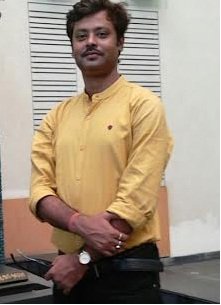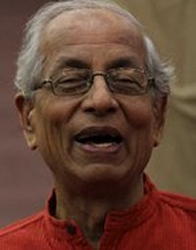
|   |

|   |
 e-mail: ukb7@rediffmail.com Male messengers of the muse March 8, 2017 Are our classical dances, especially in the manifestation of Bharatanatyam – revived and revitalized around Independence – already tending to become somewhat gender specific? Do the viewers, especially in north India and among the vast Indian diaspora, show any special preference for the female dancer with 'prettification' ruling the roost and gaudier, the better? In a land where dance as a performative art draws its genesis as well as entire inspiration from Lord Shiva as Nataraja and Lord Krishna as Natabara – both revered as dancers nonpareil - - would a trend such as this not appear to be anachronistic? There is another germane issue about the male dance teachers who nourished and nurtured the muse, giving it 'a local habitation and a name,' beginning from the legendary Thanjavur Quartet, who shaped the early Pandanallur form, followed by a string of illustrious gurus who honed Bharatanatyam in its various manifestations, including Meenakshisundaram Pillai who aided Rukmini Devi Arundale in conceiving the Kalakshetra style. Then there were Bhagavatars and masters from Andhra and Chennai who moulded Kuchipudi; Kalamandalam products, International Centre for Kathakali and others who guided the Kathakali dance-theatre to achieve its present pattern; stalwarts from the 'Jayantika' conclave who conceived the modern day Odissi; the Bindadin family and a host of others in Lucknow, Jaipur, Banaras and Raipur gharanas who showed Kathak the way forward from being mere storytellers; Manipuri Sankirtan and Raas Lila leaders who lovingly brought Manipuri to the open; and, by the turn of the twentieth century, the Sattra adhipatis who brought the male Sattriya dance to the fore. While, no doubt, the female dancers joined wholeheartedly in this exciting fray, it appeared for a long while that the male of the species was the dominant dancer-scholar-choreographer-conductor in the performance arena. Is this scene now in for an almost irrevocable change? Purush: Kolkata 2017, organized by Drishtinandan Centre of Performing Arts and its director Kush Kushari (disciple of Guru Adyar K. Lakshman), was the first pioneering seminar-cum-performance in the eastern metropolis to examine the above questions. In its director's words, "Nowadays, male participation has a minority status. There is also a very common mindset prevalent in the society that male artists are meant for background work which includes chores from accompaniments to nattuvanars. And this affects the morale of male artists who tend to eventually back out from performing. The scenario of not projecting the male artists is very much prevalent in West Bengal. Our program has been planned to present the Purusha and help him to conquer all the obstacles in his path." Dedicated to the memory of Kush's guru Adyar Lakshman, the program began with an animated morning seminar featuring noted dancer-scholars Sruti Bandopadhyay, Anurekha Ghosh and Sharmila Biswas but surprisingly few male dancers. While Sruti commented upon the skewed ratio of gender inequality in the dance field, Anurekha remarked that male dancers served different roles barring performance on stage. She brought up the mythical legend of Arjuna as Brahannala (with neuter gender) pitted unequally against Shiva performing tandava. Sharmila said she taught male dancers Chhau first, before taking them through the Odissi regimen and stressed specifically on aharya abhinaya suitable for a male role. The evening started picturesquely with five pre-teenagers dancing to swaras and increasing laya, and crossing the stage in a Mallari procession, reminiscent of south Indian temples showcasing similar, grand spectacles with nadaswaram. Subrata Pandit from Kolkata presented Kathak with uthaan in 8-1/2 beats and raga Bageshri, with splendid tatkars and chakradhars. This was followed by tihais and finally a giti, but his abhinaya left much to be desired. Dr. Vasanth Kiran from Bangalore came next with Kuchipudi, with navarasa by Narayan Murthy, followed by a spectacular tarangam on a brass plate. After demonstrating the dejected showoff by Ravana with Shiva lingam, he danced to Marathi bhajan in raga Shudh Sarang. Vasanth's considerable talents need to be held in harness to prevent degenerating into lokadharmi.  Vasanth Kiran  Sajilal K Narayanan  Subrata Pandit  Krishnendu Roy Sajilal K Narayanan from Chennai had impeccable Kalakshetra background and his alarippu with basic adavus was adequate. But thereafter, why he undertook a long Shiva stuti varnam - - rather than doing a short tillana more suitable to the mood of the occasion - - was incomprehensible. His concluding Nandanar kriti in raga Behag was a beautiful item. The finale was Odissi by Krishnendu Roy from Kolkata. His Tarijham in Shabdanritya was entirely charming. The piece de resistance comprised vignettes of a few pas de troix, with Krishnendu's Odissi colleagues Surajit Biswas and Soumen Kundu to visualize Yudhisthira-Shakuni-Draupadi, Hiranyakashipu-Prahlad-Narasinmha avatar and elephant-crocodile-Krishna confrontations, all in ekaharya abhinaya without change of costume, and came through with great elan and impact. In the context of gender specifications of nayaka and nayika, Dr. Kapila Vatsyayan provided - in her path-breaking work The Square and the Circle of the Indian Arts - an excellent analysis as to how Bharata's Natya Shastra gives rise to rasa and bhava, leading to both nayaka and nayika in kavya, natya, nritya, nritta and sangita. The concept of male actor/dancer as nayaka in Bharata's Natya Shastra is, therefore, of absorbing interest. Extracts from interview with the director Kush Kushari on Natya Shastra:  Kush Kushari How does Bharata place Nayaka and Nayika, to start with? In the opening chapter itself, Bharata says: "May the actor/dancer who adopts the role of Nayaka (hero) be under the protection of Indra. Goddess Saraswati shall protect the actress/danseuse in the heroine's role." What are the characteristics of a Nayaka visualized by Bharata? In his chapter on Prakriti, Bharata talks about the nature of human beings or characters. They are the superior or Uttama, the middling or Madhyama, and the inferior or Adhama. The superior male character is a man with full control over the sense organs; is wise and skilled in various arts and crafts; never utters a lie; is privy to enjoy pleasures; is willing to help and console poor people; is conversant with all Shastras, and is brave, liberal, patient and munificent. The Madhyama is an expert in understanding the manners of people; is proficient in arts and Shastras to make a living thereby and possesses wisdom and sweetness of manners. The inferior male character uses harsh words; is ill-mannered and base in spirit; is irascible and violent; engages himself in useless activities; haughty in manner, is ever ungrateful; does not hesitate to dishonour venerable persons; is covetous of women; fond of quarrel, treacherous to a degree and is eager to commit sinful deeds. What are the types of Nayakas according to Bharata? Identified only among the Uttama and Madhyama variety, Bharata defines four categories: Dhiroddhata, brave and haughty with self control; Dhirodatta, exalted and magnanimous, with self control; Dhiralalita, frivolous and sportive, with self control; and Dhiraprashanta, calm and quiescent, with self control. We interpret Dhira to mean self control as would behove the Nayaka. Typically, the gods are Dhiroddhata; the ministers and commanders-in-chief are Dhirodatta; the royal dignitaries are Dhiralalita; and the Brahmins and merchants are Dhiraprashanta. The qualities laid down seem to be in relation to the duties performed for that particular position. In Bharata's time, probably plays already existed which had a clear character sketch about the four Nayaka types. Since you mention plays, could you cite Bharata's specific advice on how abhinaya of Nayaka would apply equally to dance? In the chapter on Samanya Abhinaya (Basic Representation), Bharata explains how this originates from words, gestures and Sattva (temperament). Indeed, Sattvik Abhinaya is something whose exuberance is superior to all other forms of abhinaya and should remain as the main plank for bhava and rasa. Eight aspects of male temperament, indicated by Bharata, are: Shobha (brilliant character, with emulation of best virtues); Vilasa (graceful deportment, where eyes boldly move forward, gait is graceful and speech is attended with smile); Madhurya (self-possession, retaining firmness of sense organs); Sthairya (steadiness, not giving up any task undertaken); Gambhirya (gravity, sans reaction in spite of anger, joy or fear); Lalita (sportiveness, naturally tender, but not wanton); Audarya (nobility, readiness to make gifts and speak sweetly to others); and Tejas (spiritedness, intolerant of the words of reproach and insult). According to Bharata, Samanya Abhinaya should be a combination of Angika, Vachika and Sattvika. As explained by Abhinava Gupta, it is the consequence of combining all abhinayas, just as fragrance emanates from blending many sweet smelling substances. Finally, how does a Nayika address the Nayaka based on his character? Bharata gives various possibilities of interaction particularly between a Khandita Nayika and the Nayaka. For instance, if a Nayaka does nothing undesirable, speaks nothing improper and always reveals an upright conduct, the Nayika may address him as 'Priya'. On the other hand, the Nayika would address him as 'Satha', when the Nayaka speaks sweet words to suit his own purpose and indulges in misdoings behind her back. In between these two extremes, a 'Dhrishta' Nayaka is one who pleads for Nayika's forgiveness when he realizes his mistake and is overcome by remorse.  Dr. Utpal K Banerjee is a scholar-commentator on performing arts over last four decades. He has authored 23 books on Indian art and culture, and 10 on Tagore studies. He served IGNCA as National Project Director, was a Tagore Research Scholar and is recipient of Padma Shri. Post your comments Please provide your name and email id when you use the Anonymous profile in the blog to post a comment. All appropriate comments posted with name & email id in the blog will also be featured in the site. |